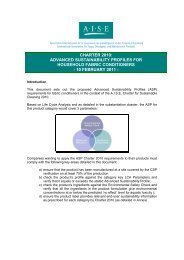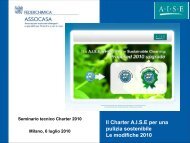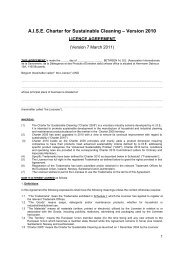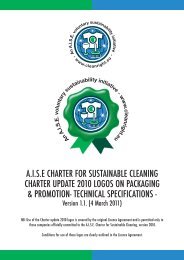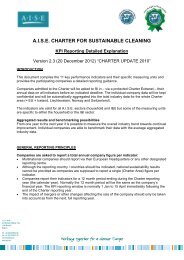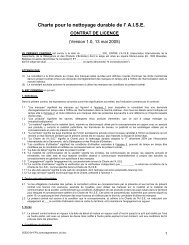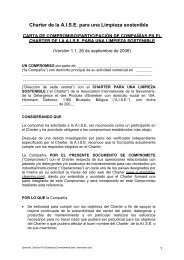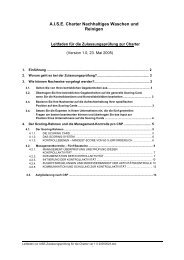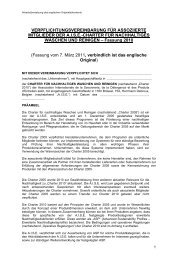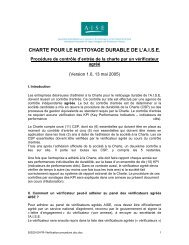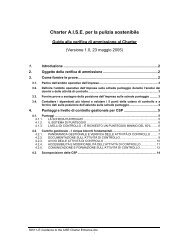ASP Substantiation Dossier - Sustainable Cleaning
ASP Substantiation Dossier - Sustainable Cleaning
ASP Substantiation Dossier - Sustainable Cleaning
You also want an ePaper? Increase the reach of your titles
YUMPU automatically turns print PDFs into web optimized ePapers that Google loves.
Product formulation<br />
Based on the outcome of the life-cycle analysis, the LCA experts identified the concentration of a<br />
product as one of the key factors, in order to reduce the environmental impact. Within the<br />
geographical scope of the Charter, it can be observed from products on shelves that the standard<br />
dose of liquid laundry detergents varies from 35 ml to over 120 ml (as at end 2009).<br />
In the framework of A.I.S.E.’s sustainability initiatives 4 , an LCA Expert Working Group has developed<br />
a preliminary evaluation based on the hypothesis of concentrating the current “dilute” liquid detergents<br />
to a level that would allow obtaining a performance equivalent to today’s products with a maximum<br />
dosage of 75 ml. These calculations show that this threshold has the potential to lead to an<br />
ingredients savings of around 400,000 tons in the EU 27. An industry consultation took place in 2008<br />
through the A.I.S.E. National Associations network which confirms that 75 ml is achievable by SMEs<br />
through conventional technology. Therefore it appears as setting a right balance between the aim to<br />
reach environmental savings and the possibility to achieve it through conventional technology<br />
available to all companies, including SMEs. “Conventional technology” should be understood as<br />
technology that is already widely used or readily accessible to all companies.<br />
Based on the market situation in Europe 2009 (source Nielsen), 42,9% of laundry detergent liquids<br />
fulfil the 75 ml per wash threshold. The proposed threshold therefore appears as an ambitious<br />
proposal for substantial environmental savings. This threshold was confirmed as one outcome of the<br />
consultation.<br />
Packaging<br />
Based on the outcome of the life-cycle analysis, the LCA experts identified the reduction of packaging<br />
as a further key factor, in order to reduce environmental impact. The criteria of 7g per job has been<br />
proposed on the basis that it is achievable using readily available technology but currently only met by<br />
around half the market, on the basis of data provided to A.I.S.E. The consultation sought to gain<br />
further insight into this aspect to assess the feasibility of this threshold or a lower threshold. A<br />
threshold of 7g per job was confirmed as one outcome of the consultation. In addition the consultation<br />
sought views on whether only non-recycled content in bottles should be taken into account when<br />
weighing packaging against the proposed threshold. This provision aims to encourage the use of recycled<br />
packaging.<br />
e.g. : for a given total packaging (primary + secondary) of 9g per job and containing 2.2 g per job<br />
of recycled material, only 6.8 g per job will need to be taken into account.<br />
This was confirmed in the consultation. In order to meet the target, the liquid laundry detergent will<br />
need to be packed/bottled in a way that is not wasteful, i.e. without excessive empty space in the<br />
pack/bottle, and with efficient usage of secondary packaging.<br />
4 Reference can be requested from the A.I.S.E. Secretariat.<br />
7




